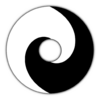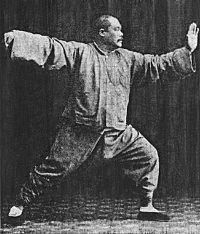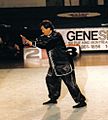Tai chi facts for kids
 |
|
|---|---|
| The lower dantian in Taijiquan: Yin and Yang rotate, while the core reverts to stillness (wuji). |
|

Yang Chengfu (c. 1931) in Single Whip posture of Yang-style t'ai chi ch'uan solo form
|
|
| Also known as | tàijí; t‘ai chi |
| Focus | Chinese Taoist |
| Hardness |
|
| Country of origin | China |
| Creator | Said to be Chen Wangting or Zhang Sanfeng |
| Famous practitioners |
|
| Olympic sport | Demonstration only |
Tai chi (Chinese: 太極; pinyin: Tàijí), short for T'ai chi ch'üan or Tàijí quán (太極拳), is an internal Chinese martial art practiced for both its defense training, its health benefits and meditation. The term taiji is a Chinese cosmological concept for the flux of yin and yang, and 'quan' means fist. So etymologically, Taijiquan is a fist system based on the dynamic relationship between polarities (Yin and Yang). Though originally conceived as a martial art, it is also typically practiced for a variety of other personal reasons: competitive wrestling in the format of pushing hands (tui shou), demonstration competitions and achieving greater longevity. As a result, a multitude of training forms exist, both traditional and modern, which correspond to those aims with differing emphasis. Some training forms of tai chi are especially known for being practiced with relatively slow movements.
Today, tai chi has spread worldwide. Most modern styles of tai chi trace their development to at least one of the five traditional schools: Chen, Yang, Wu (Hao), Wu and Sun. All of the former, in turn, trace their historical origins to Chen Village.
Related pages
Images for kids
-
Outdoor practice in Beijing's Temple of Heaven.
See also
 In Spanish: Taichí para niños
In Spanish: Taichí para niños










